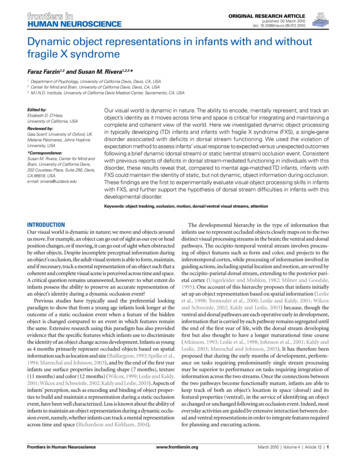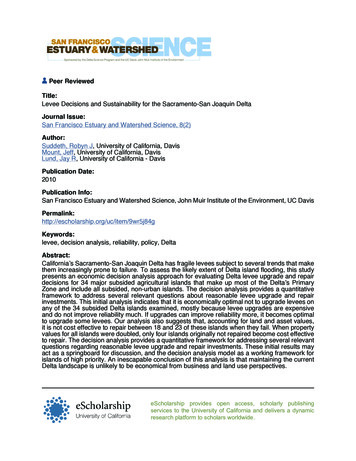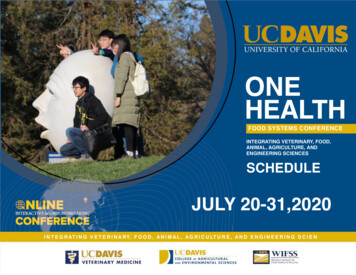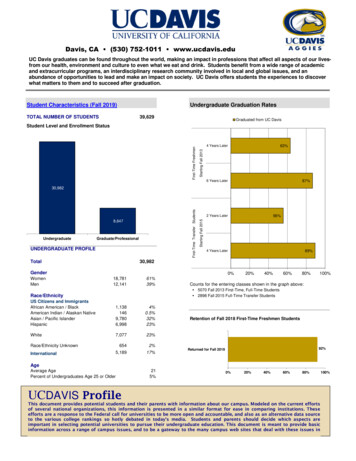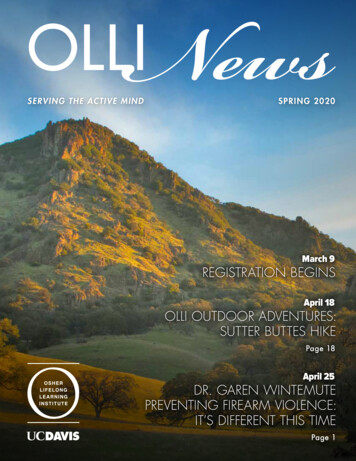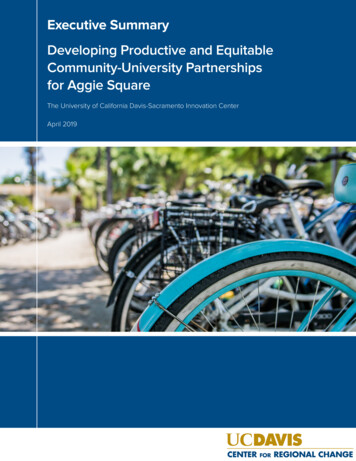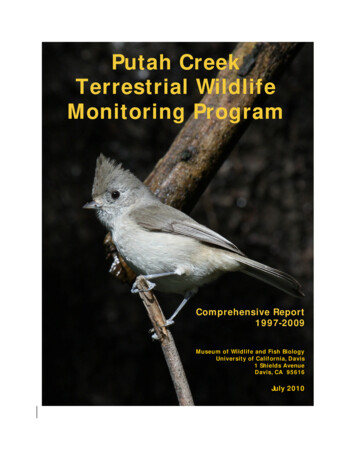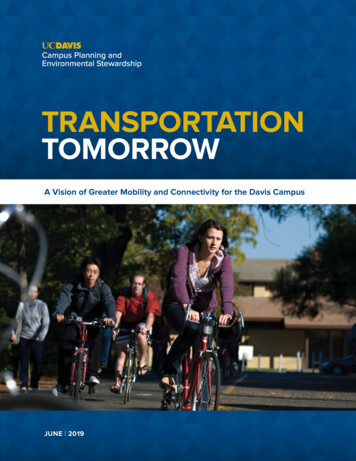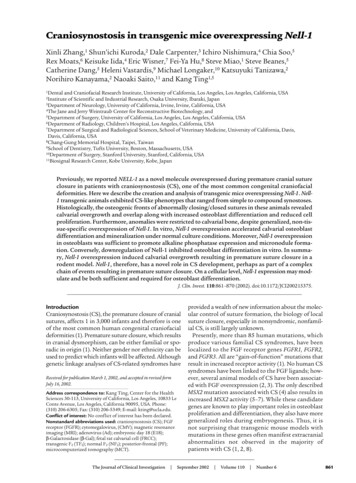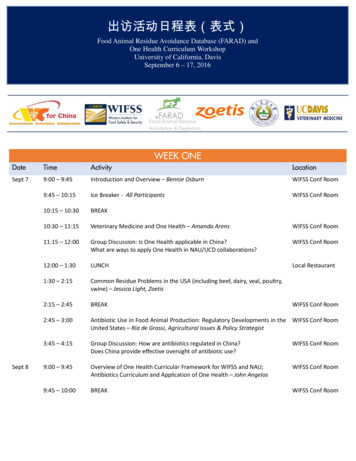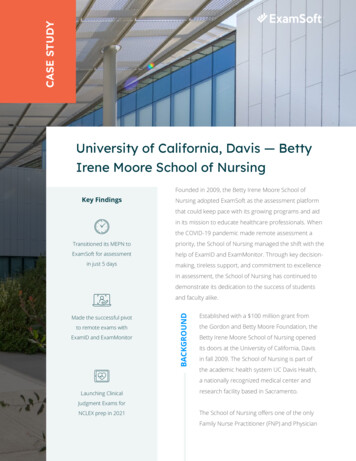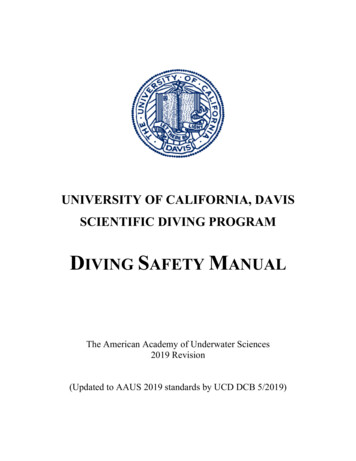
Transcription
UNIVERSITY OF CALIFORNIA, DAVISSCIENTIFIC DIVING PROGRAMDIVING SAFETY MANUALThe American Academy of Underwater Sciences2019 Revision(Updated to AAUS 2019 standards by UCD DCB 5/2019)
FOREWORDA researcher's presence in the environment has proven to be an improved method of collecting data.Specifically, the effectiveness of the underwater scientist lies in having the trained mind and eye at sitesof primary interest. The superior observational capabilities of the human eye in depth perception andcolor sensitivity, the use in diving of the sense of touch and the special ability of the human mind tointegrate the field observation and to provide rapid feedback, are of prime importance in such areas asspatial distribution, population dynamics, behavior and dynamic geological processes (Jim Stewart,1988).In short, diving, when conducted in a manner, which will maximize protection of the scientific diverwhile allowing efficiency of observation, is a tool of great potential value, a means of collecting data,which in many cases is available through no other means.This document is drawn from the American Academy of Underwater Sciences (AAUS) Standards forScientific Diving Certification and Operations of Scientific Diving Programs, of 2019. Since 1951 thescientific diving community has endeavored to promote safe, effective diving through self-imposeddiver training and education programs. Over the years, manuals for diving safety have been circulatedbetween organizations, revised and modified for local implementation, and have resulted in an enviablesafety record. This manual, derived from the AAUS document, represents the minimum safety standardsfor scientific diving at the present day. It will be continuously reviewed by the University of CaliforniaDavis Diving Control Board and Diving Safety Officer to see that it always reflects state of the art, safediving practices.UC Davis Diving Safety Officer1
Table of ContentsVolume 1 . 5Section 1.00 GNERAL POLICY . 61.10 Scientific Diving Standards . 61.20 Operational Control . 71.30 Consequence of Violation of Regulations by Scientific Divers .121.40 Consequences of Violation of Regulations by Organizational Members .121.50 Record Maintenance .12SECTION 2.00 DIVING REGULATIONS .132.10 Introduction .132.20 Pre-Dive Procedures .132.30 Diving Procedures .142.40 Post-Dive Procedures .152.50 Emergency Procedures .152.60 Flying After Diving or Ascending to Altitude (Over 1000 feet/304 meters) .152.70 Record Keeping Requirements .15SECTION 3.00 DIVING EQUIPMENT .173.10 General Policy .173.20 Equipment .173.30 Auxiliary Equipment .183.40 Support Equipment .183.50 Equipment Maintenance .18SECTION 4.00 SCIENTIFIC DIVER CERTIFICATION AND AUTHORIZATIONS .204.10 Prerequisites .204.20 Training .204.30 Diver Certification and Authorizations .244.40 Depth Authorizations.244.50 Maintaining Active Status .252
4.60 Revocation of Authorization .26SECTION 5.00 MEDICAL STANDARDS .275.10 Medical Requirements .275.20 Frequency of Medical Evaluations .275.30 Information Provided Examining Physician.275.40 Content of Medical Evaluations .275.50 Physician’s Written Report.27Volume 2 . 29SECTION 6.00 NITROX DIVING .306.10 Requirements for Nitrox Authorization .306.20 Minimum Activity to Maintain Authorization .316.30 Operational Requirements .316.40 Nitrox Diving Equipment .32SECTION 7.00 Surface Supplied Diving Technologies .337.10 Prerequisites .337.20 Surface Supplied Diving.337.40 Hookah .34SECTION 8.00 STAGED DECOMPRESSION DIVING .368.10 Minimum Experience and Training Requirements.368.20 Minimum Equipment Requirements.378.30 Minimum Operational Requirements .37SECTION 9.00 MIXED GAS DIVING .399.10 Minimum Experience and Training Requirements.399.20 Equipment and Gas Quality Requirements .409.30 Minimum Operational Requirements .40SECTION 10.00 SPECIALIZED DIVING ENVIRONMENTS .4110.10 Blue Water Diving .4110.20 Altitude Diving .4110.30 Ice and Polar Diving .413
10.40 Overhead Environments .4110.50 Saturation Diving .4110.60 Aquarium Diving .41SECTION 11.00 REBREATHERS .43SECTION 12.00 SCIENTIFIC CAVE AND CAVERN DIVING .44Appendices. 45APPENDIX 1 DIVING MEDICAL EXAM OVERVIEW FOR THE EXAMINING PHYSICIAN .45APPENDIX 2 AAUS MEDICAL EVALUATION OF FITNESS FOR SCUBA DIVING REPORT .47APPENDIX 2b AAUS MEDICAL EVALUATION OF FITNESS FOR SCUBA DIVING REPORT .48APPENDIX 3 DIVING MEDICAL HISTORY FORM.49APPENDIX 4 RECOMMENDED PHYSICIANS WITH EXPERTISE IN DIVING MEDICINE .52APPENDIX 5 DEFINITION OF TERMS .53APPENDIX 6 Letter of Reciprocity or Verification of Training .58APPENDIX 7 EMERGENCY ACTION PLAN .59APPENDIX 8 AAUS STATISTICS COLLECTION CRITERIA AND DEFINITIONS .62APPENDIX 9 Recommendations For Rescue Of A Submerged Unresponsive Compressed-Gas Diver .66APPENDIX 10 Scientific Dive Checklist .67APPENDIX 11 SHARK ACTIVITY RECOMMENDATIONS.68APPENDIX 12 UC Davis Guidelines for Snorkeling and Free Diving .694
Volume 1Sections 1.00 through 5.00Required For All Organizational Members5
SECTION 1.00 GENERAL POLICY1.10THE SCIENTIFIC DIVING STANDARDSPurposeThe purpose of these Scientific Diving Standards is to ensure scientific diving is conducted in amanner that will maximize the protection of scientific divers from accidental injury and/orillness, and to set forth standards for training and certification that will allow a workingreciprocity between Organizational Members (OMs or OM). Fulfillment of these purposes shallbe consistent with the furtherance of research and safety, and facilitation of collaborativeopportunities between AAUS OMs.This Manual sets minimum standards for the establishment of American Academy ofUnderwater Sciences (AAUS) recognized scientific diving programs, the organization for theconduct of these programs, and the basic regulations and procedures for safety in scientificdiving operations. It also establishes a framework for reciprocity between AAUS OMs thatadhere to these minimum standards.Historical PerspectiveThis Manual was developed and written by AAUS by compiling the policies set forth in thediving manuals of several university, private, and governmental scientific diving programs.These programs share a common heritage with the scientific diving program at the ScrippsInstitution of Oceanography (SIO). Adherence to the SIO standards has proven both feasibleand effective in protecting the health and safety of scientific divers since 1954.In 1982, OSHA exempted scientific diving from commercial diving regulations(29CFR1910, Subpart T) under certain conditions that are outlined below. The final guidelinesfor the exemption became effective in 1985 (Federal Register, Vol. 50, No.6, p.1046). AAUS isrecognized by OSHA as the scientific diving standard setting organization.Scientific Diving DefinitionScientific diving is defined (29CFR1910.402) as:“Diving performed solely as a necessary part of a scientific, research, or educational activity byemployees whose sole purpose for diving is to perform scientific research tasks. Scientific divingdoes not include performing any tasks usually associated with commercial diving such as:Placing or removing heavy objects underwater; inspection of pipelines and similar objects;construction; demolition; cutting or welding; or the use of explosives.”Scientific Diving ExemptionThe two elements that a diving program must contain as defined by OSHA in 29 CFR 1910Subpart T 1910.401(a)(2)(iv) are:a) Diving safety manual which includes at a minimum: Procedures covering all divingoperations specific to the program; procedures for emergency care, includingrecompression and evacuation; and criteria for diver training and certification.6
b) Diving control (safety) board, with the majority of its members being active divers,which must at a minimum have the authority to: Approve and monitor diving projects;review and revise the diving safety manual; assure compliance with the manual; certifythe depths to which a diver has been trained; take disciplinary action for unsafe practices;and, assure adherence to the buddy system (a diver is accompanied by and is incontinuous contact with another diver in the water) for SCUBA diving.OSHA has granted an exemption for scientific diving from commercial diving regulations underthe following guidelines (Appendix B to 29 CFR 1910 Subpart T): The Diving Control Board consists of a majority of active scientific divers and hasautonomous and absolute authority over the scientific diving program’s operation. The purpose of the project using scientific diving is the advancement of science; therefore,information and data resulting from the project are non-proprietary. The tasks of a scientific diver are those of an observer and data gatherer. Construction andtrouble-shooting tasks traditionally associated with commercial diving are not includedwithin scientific diving. Scientific divers, based on the nature of their activities, must use scientific expertise instudying the underwater environment and therefore, are scientists or scientists-in-training.Recommendations for Changes to AAUS ManualAs part of each OMs annual report, recommendations for modifications of this Manual must besubmitted to AAUS for consideration.LiabilityIn adopting the policies set forth in this manual, the University assumes no liability not otherwiseimposed by law. Each diver is assumed under this policy to be voluntarily performing activities forwhich he/she assumes all risks, consequences, and potential liability.Release and WaiverAll students and other personnel (other than University employees) diving under University auspices shallexecute a release holding the Regents harmless from any claims which might arise.1.20OPERATIONAL CONTROLUniversity Auspices and ResponsibilitiesUCD auspices include any scientific diving operation in which UCD is connected because of ownership oflife support equipment used, locations selected, or relationship with the associated individual(s). Thisincludes all cases involving the operations of authorized individuals of UCD or auxiliary organizations,where such individuals are acting within the scope of their authorization.It is UCD’s responsibility to adhere to the AAUS Standards for Scientific Diving Certification and Operationof Scientific Diving Programs. The administration of the local diving program will reside with the DSO inconsultation with the UCD Diving Control Board. The regulations herein shall be observed at all locationswhere scientific diving is conducted.7
The Diving Safety ManualUCD shall develop and maintain a Diving Safety Manual (DSM), which provides for the development andimplementation of policies and procedures that will enable UCD to meet requirements of local environments andconditions as well as to comply with the AAUS minimum standards.Diving Control Board The DCB shall consist of a majority of active scientific divers. Membership shall consist of threefaculty, one staff, and one student representative. The Chair of the Board shall be a facultymember, and will represent the Vice Chancellor-Research. Other members will be the DivingSafety Officer, a physician who is familiar with diving medicine (The Diving Medical Officer), arepresentative of the UCD instructional staff, the Senior Divers at the TERC, SeaDoc, and BML.A secretary may be chosen from the membership of the board according to DCB procedures.Has autonomous and absolute authority over the scientific diving program’s operation.The DCB must:o Establish additional standards, protocols, and operational procedures beyond the AAUSminimums to address specific needs and concerns.o Approve and monitor diving projects.o Review and revise the diving safety manual.o Ensure compliance with the diving safety manual.o Approve the depth to which a diver has been authorized to dive.o Take disciplinary action for unsafe practices.o Ensure adherence to the buddy system for scientific diving.o Act as the official representative of UCD in matters concerning the scientific divingprogram.o Act as a board of appeal to consider diver-related problems.o Recommend the issue, reissue, or the revocation of diving authorizations.o Recommend changes in policy and amendments to AAUS and UCD’s diving safetymanual as the need arises.o Establish and/or approve training protocols or standards through which the applicants forauthorization can satisfy the requirements of UCD’s diving safety manual.o Suspend diving operations considered to be unsafe or unwise.o Establish criteria for equipment selection and use.o Recommend new equipment or techniques.o Establish and/or approve facilities for the inspection and maintenance of diving andassociated equipment.o Ensure that UCD’s air station(s) meet air quality standards as described in Section 3.60.o Periodically review the DSO’s performance and program.o Investigate diving incidents within the UCD’s diving program or violations of UCD’sdiving safety manual.The DCB may delegate operational oversight for portions of the program to the DSO; however,the DCB may not abdicate responsibility for the safe conduct of the diving program.Diving Safety OfficerThe Diving Safety Officer (DSO) serves as a voting member of the DCB, and should bedesignated one of the OM Representatives to AAUS. This person should have broad technicalexpertise and experience in research related diving.8
Qualifications:1.Must be an active scuba instructor from an internationally recognized certifyingagency.2.Must be appointed by the responsible administrative officer or designee, with theadvice and counsel of the DCB.3.Must qualify as a Full Voting Member of AAUS as defined by AAUS Bylaws:“(a) Holds a diving certification from a recognized national certifying agency orequivalent, and(b) Has engaged in sustained or successive scientific diving activities during thepast two years, or(c) Has completed a course in scientific diving that meets the requirements asspecified by the most current edition of the AAUS Standards for ScientificDiving.”4.Must attend an AAUS DSO Orientation within one year of accepting a position atUCD, unless he/she has served as a DSO for another current AAUS OM within thelast year.Duties and Responsibilities1.Answers, through the DCB, to the appropriate administrative officer or designee, forthe conduct of the scientific diving program at UCD.2.If delegated by the DCB, the routine operational authority for this program rests withthe DSO. This oversight includes, but is not limited to: training, diver authorizations,approval of dive plans, maintenance of diving records, and ensuring compliance withthis Manual.3.May permit some duties and responsibilities to be carried out by a qualified delegate,with the approval of the DCB.4.Must be guided in the performance of the required duties by the advice of the DCB,but operational responsibility for the conduct of the scientific diving program will beretained by the DSO.5.Must suspend diving operations determined to be unsafe or unwiseInstructional PersonnelAll personnel involved in diving instruction under the auspices of UC Davis shall bequalified for the type of instruction being given, and hold active leadership certificationfrom a nationally recognized training agency. Instructional personnel will be selected bythe responsible administrative officer, or her/his designee, who will solicit the advice ofthe DCB in conducting preliminary screening of applicants for instructional positions.9
Lead DiverFor each dive, one individual shall be designated as the Lead Diver who shall be at the divelocation during the diving operation. The Lead Diver shall be responsible for: Ensuring dives are conducted in accordance with Section 2.0.Ensuring all dive team members possess current authorization and are qualified for the typeof diving operation.Coordination with other known activities in the vicinity that are likely to interfere withdiving operations.Ensuring safety and emergency equipment is in working order and at the dive site.Suspending diving operations if in their opinion conditions are not safe.Reporting to the DCB, through the DSO, any physical problems or adverse physiologicaleffects including symptoms of pressure-related injuries.Reciprocity and Visiting Scientific Diver Two or more AAUS OMs engaged jointly in diving activities, or engaged jointly in the use ofdiving resources, must designate one of the participating DCBs to govern the joint dive project.However, responsibility for individual divers ultimately resides with the home institution.A Scientific Diver from one OM must apply for permission to dive under the auspices of anotherOM by submitting to the DSO of the host OM a document containing all the information listed inAppendix 6, signed by the DSO or designee of the home DCB.A visiting Scientific Diver may be asked to demonstrate their knowledge and skills for theplanned dive.If a host OM denies a visiting Scientific Diver permission to dive, the host DCB must notify thevisiting Scientific Diver and their DCB with an explanation of all reasons for the denial.UC Davis Dive Team CompositionEach UCD diver should be paired with another active AAUS diver verified by an institutional Letterof Reciprocity (LOR). If the non-UCD diver cannot secure a LOR, approval to dive with a UCDdiver must be obtained from the UCD Diving Control Board or their designee. The primary concernof the Dive Safety Program is that all dive buddies have appropriate training and experience,medical and physical fitness to dive and recent diving activity in similar environments. Thefollowing steps outline how approval can be obtained when a LOR cannot be presented.DefinitionsStaff Diver: paid or volunteer UCD staff that will be a participant on a dive team. This person can bea faculty, postdoc, staff, graduate or undergraduate student. This person will be covered under UCDworker’s compensation program and will be incorporated into UCD’s diver database (Webdiver).Collaborator: non-paid, non-volunteer, non-UCD diver that may be a participant on a dive team.This person will be diving under their home academic institution auspices and will not be coveredunder UCD’s worker’s compensation program. They will not be incorporated into Webdiver.Unaffiliated Dive Buddy: due to research constraints, the UCD diver needs to dive with the mostqualified diver available in the area of operation. This person is not affiliated with an academicinstitution but shall have his/her own liability insurance and medical coverage.10
REQUIREMENTS FOR ABOVE DIVERSUCD Staff Divers:1) If they have active scientific diver status with an AAUS institution, a Letter of Reciprocity isrequired. A checkout dive may also be required.2) If they were trained as a scientific diver at an AAUS institution but are currently unaffiliatedwith an AAUS institution, a Verification of Training is required. All documentation required to be acurrent UCD scientific diver must be presented prior to a checkout dive with the UCD DSO or his/herdesignee.3) If they have scientific diving experience but no documented training the diver will need to gothrough a five-day challenge course at UCD to document swimming and scuba skills, knowledge ofdiving related topics and an open water checkout that includes a complete unconscious diver rescue.4) If any aspect of section “3” cannot be met, the Diving Control Board will need to review andapprove the diver for the intended project.Collaborators:1) If they have active scientific diver status with an AAUS institution a Letter of Reciprocity isrequired.2) If they were trained as a scientific diver at an AAUS institution but are currently unaffiliatedwith an AAUS institution, a Verification of Training is required. All documentation equivalent tobeing a current UCD scientific diver will be required.3) If they have scientific diving experience but no documented AAUS training, the diver willneed to provide the following documentation: Authorization from their home institution to doscientific diving on the project; coverage for diving medical emergencies (DAN insurance); medicalapproval to be diving (letter from a physician); copies of dive certification cards; documentation ofdiving first aid training (First Aid/CPR/O2); proof of regulator/gauge/BCD inspection/service withinthe last year and their last 12 dive logs.4) If any aspect of section “3” cannot be met, the Diving Control Board will need to review andapprove the diver for the intended project.Unaffiliated Dive Buddy:1. The UCD diver shall conduct dives through an established diving operation that is recognizedby an international training agency or institution, and has a website and email connectivity.2. The unaffiliated dive buddy shall be a Divemaster (DM) or Dive Instructor affiliated with thediving operation or an independent and locally active DM or Instructor. The dive buddy must providedocumentation of currency as a DM or Instructor by emailing a copy of their current card and divelog for last six months to the UCD DSO or designee.3. Lacking a locally active DM or Instructor the potential dive buddy shall be reviewed on a caseby case basis and approved by the Diving Control Board for the intended project.4. Unaffiliated dive buddies must show self-insurance in regards to medical and liabilitycoverage before diving operations are approved.Waiver of RequirementsThe DCB may grant a waiver for specific requirements of training, examinations, depthauthorizations, and minimum activity to maintain authorizations. AAUS medical standards maynot be waived.11
1.30 Consequence of Violation of Regulations by Scientific DiversFailure to comply with the regulations of the UCD’s diving safety manual may be cause for therestriction or revocation of the diver’s scientific diving authorization by action of the UCD DCB.1.40 Consequences of Violation of Regulations by Organizational MembersFailure to comply with the regulations of this Manual may be cause for the restriction orrevocation of the UCD’s recognition by AAUS.1.50 Record MaintenanceUCD must maintain consistent records for its diving program and for each participant. Theserecords include but are not limited to: diving safety manual; equipment inspection, testing, andmaintenance records; dive plans (project and/or individual); records of dive (project and/orindividual)
Placing or removing heavy objects underwater; inspection of pipelines and similar objects; construction; demolition; cutting or welding; or the use of explosives." Scientific Diving Exemption The two elements that a diving program must contain as defined by OSHA in 29 CFR 1910 Subpart T 1910.401(a)(2)(iv) are:
